|
|
|
|
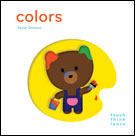
|
Colors
by Xavier Deneux
Deneux has released two new boardbooks under a brand of Touchthinklearn: Colors and Opposites. With raised shapes on the left page, mirrored by a cutout of the same shape on the right page, each item is carefully considered. High contrast art will appeal to young eyes while the tactile experience of raised and cutout areas on the page will be of extreme interest to young fingers (and possibly mouths). Colors utilizes a standard palette of rainbow colors with black and white to showcase items in each color. Judicious use of white space is extremely attractive. Opposites was not seen. However both are recommended for ages 6 months to 3 years. (These are translations of French titles from 2012.)
--Tracy Gallagher, MLIS, Collection Development |
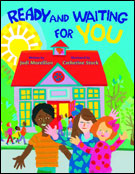
|
Ready and Waiting for You
by Judy Moreillon
“We’re ready and waiting for you” is the ongoing theme throughout this title as teachers are welcoming new students with smiles putting to rest any first day jitters a child might have of going to school. Crayon box colors are used on illustrations covering the whole page as kids of all ages are dressed in their first day finest ready to take part in this new adventure. Each set of pages has a fold-out page inviting the reader to come in through the doors to the library, art room, gymnasium, classroom and the most important door around noontime the door to the cafeteria! Moreillon provides a great opportunity for parents to introduce school personnel to their children as the principal, cook, librarian, secretary, custodian and many others are shown in their specialty areas with the repeated message “everyone’s waiting for you.” Parents will want to read this warm and friendly title in the weeks leading up to that most important day of their child’s life. Recommended for age 4 to 7.
--Jeanne Martin, M.Ed., Collection Development |
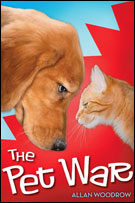
|
The Pet War
by Allan Woodrow
Siblings fight over just about everything, and which pet to have is certainly one of the hot topics for bickering. Eleven-year-old Otto wants a dog, and of course his older and annoyingly perfect sister Lexi wants a cat. Not just any cat but a cat she can name “Fluffernutter”! Well, this just can’t come to pass. Otto MUST get a dog. When their mother suggests that whoever can raise five hundred dollars before the end of the month gets to decide whether the family pet is canine or feline, it is all-out war! Otto gets himself into one money-making (or is that money-losing?) debacle after another, while it seems Lexi is a born entrepreneur. Even with smart friend Malcolm giving him profitable ideas, poor Otto just seems to stay in the dog house! Readers will enjoy rooting for Otto, with his self-deprecating sense of humor and never-give-up-get-that-dog attitude, and they most definitely will keep reading to find out if the home is filled with woofs or meows! Recommended for ages 8 to 11.
-- Becky Walton, MLIS, Collection Development |
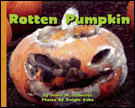
|
Rotten Pumpkin: A Rotten Tale in 15 Voices
by David M. Schwartz, photos by Dwight Kuhn
From the opening disclaimer of “No animals, molds, or fungi were harmed in the making of this book, but some pumpkins got pretty mushy,” the tone is set for a decompositional journey so fun, kids won’t realize they are being educated about consumer-resource systems! The tale begins on a Halloween night. The first voice is Jack the jack-o’-lantern who, having proudly performed his duty, is now relegated to the garden to rot. The voices that follow are those of the various flora and fauna that contribute to the final stages of Jack’s lifecycle: squirrels take any leftover seeds, mold spores land on Jack and grow, earthworms dine on the pumpkin flesh and their droppings provide nutrients to the soil, and so on. The color photos of the process are delightfully gross: close-ups of Jack as he gradually turns mushier and gooier, gets covered with thicker and thicker layers of mold, and finally returns to the earth. There’s no sad ending to this gourd saga: one of Jack’s seeds found its way down into the rich soil and sprouts to begin the cycle all over again. Never did I think I would read a book containing the word “plasmodium” and have such a blast! Librarians and teachers, know this: the yucky images will have the kids yelling “gross” while they rapidly devour the book and have you grinning like a jack-o’-lantern because you slipped in an ecological food chain lesson! Highly and rottenly recommended for ages 8 to 11.
-- Becky Walton, MLIS, Collection Development
|
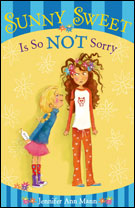
|
Sunny Sweet is So Not Sorry
by Jennifer Ann Mann
Debut novelist Mann hits the sweet spot for lower middle-grade realistic stories, keeping company with the masters--Clements, Blume, and Cleary. Long-suffering Masha Sweet has an evil genius for a younger sister, six-year-old Sunny: "She was born brilliant...she'll invent some poisonous gas that will snuff out the sun and freeze us all into human Popsicles, but until that time, she seems perfectly content to practice her evil schemes on me." Sunny's latest evil scheme is to glue plastic flowers into Masha's hair so she'll stand out more and people will like her at school (having read Masha's diary to know this is her fervent wish.) A madcap adventure follows in which Sunny and Masha find themselves at the local hospital, Sunny thrilled to be able to make the rounds with the doctor and share her diagnoses, and Masha trying to clean up all Sunny's messes (and a few of her own.) The spot art illustrations are delightful; they perfectly depict Masha's endless frustration with a cuter younger sibling always getting away with murder, but also the inevitable love and bond between sisters. Your young humor fans will be thrilled to learn this is a start of series, with book two slated to publish May 2014. Recommended for ages 8 to 11.
--Jill M. Barton, MLIS, Collection Development
|
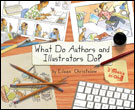
|
What Do Authors and Illustrators Do?
by Eileen Christelow
Great story ideas can come from everyday events as many authors know. Take the scenario of the vivacious collie Rufus. While chasing Max the cat, the tables turn and Max is now chasing Rufus as both land with a splash in the pond while riding a little red wagon. Just like that a picture book idea is formed and can now be written. Well, not that quick, the writing process is just beginning. Christelow uses fun comic panels to present the two authors writing their first picture books with the help of Rufus and Max, of course. Appealing facial features full of expressions depicting deep thinking, questioning, frustration and jubilation have the reader feeling each emotion that the budding author is going through. Are the correct descriptive words used? Should a detailed outline be written? How about more research? Will at least one publisher like the manuscript amidst all the rejections? Congratulations! One publisher is interested, but what? The editors want a rewrite on a certain section of the book just when you thought it was completed? Now the book is ready for the printers just in time to schedule personal appearances to sell it into libraries and stores. Writing a book is more involved than you thought! The story doesn’t end here though; Christelow now takes the reader through the process the illustrator goes through adding two new pets, Scooter and Leonard to help out. How hard can drawing be one might ask, but again many decisions have to be made when illustrating a title. Is there enough room left on the page for the words amidst the drawings? Should the illustration be a close-up or bird’s - eye view? Pencil, ink, watercolor, which shall it be? Again, Christelow uses her watercolor characters in the cartoon panel format to help make this an enjoyable read for all interested in illustrating. Activities are included in the end matter to help assist the budding author or illustrator along with information for a delightful interactive website allowing the participant to help draw and color illustrations Christelow has used in her book. Add this title to the career section in your library for the aspiring young author/illustrator.
Recommended for ages 8 to 11.
--Jeanne Martin, M.Ed., Collection Development
|

|
Bluffton: My Summer with Buster Keaton
by Matt Phelan
In his poignant graphic novel Bluffton, award-winning author/illustrator Matt Phelan (Storm in the Barn, Around the World) transports readers to an earlier, simpler time: Bluffton, Michigan, in the years 1908-10, where the protagonist Henry befriends a talented, young Vaudeville performer (and future silent film comedian) named Buster Keaton. The beautiful watercolor illustrations and economical dialogue weave a nostalgic tale of three magical summers sure to please readers of all ages. This graphic novel is highly recommended for ages 9-12.
--Jenny McCluskey, MSIS, Collection Development
|
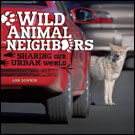
|
Wild Animal Neighbors: Sharing Our Urban World
by Ann Downer
Downer’s followup to 2011’s Elephant Talk: The Surprising Science of Elephant Communication considers why and how some wild animals are making homes in the human ecosystem. Each chapter examines a particular species, such as bears, raccoons, and alligators, and why they are becoming a more frequent sight in cities around the world and efforts to control the human-animal interactions. Downer stresses the enormous negative impact that habitat fragmentation has on large animals, such as the North American mountain lion, and one solution – a wildlife corridor – that can be successful if humans make the decision to save apex predators. Sidebars provide additional information on the species and most pages feature a color photograph. There is much here to stimulate young minds: I challenge one person to read the chapter about young adult Zander Srodes and his campaign to save sea turtles (and hopefully go further and watch his TEDxTeen talk) and NOT become passionate about wildlife protection. Downer concludes her book with a succinct explanation of why humans should preserve biodiversity and protect our wild animal neighbors. Pair this gem with City Critters: Wildlife in the Urban Jungle by Nicholas Read for a slighter older audience and the “City Critters” series from Windmill Books for a slightly younger audience. Wild Animal Neighbors is a must for your 500s and highly recommended for ages 11 and up.
-- Becky Walton, MLIS, Collection Development
|
September 21st is the UN's International Peace Day. In this month's issue, we offer some relevant titles.
|

|
Llama Llama and the Bully Goat
by Anna Dewdney
Yes, I am a huge Llama Llama fan and the newest book validates my love for Llama Llama (and his author/illustrator) completely. Llama Llama has grown up enough that he goes to school and enjoys lots of fun things such as writing, counting, drawing, and playing with clay. Everything about school is terrific except for Gilroy Goat. Gilroy Goat is a Bully Goat and that is just not fun. Even though Teacher has been clear that bullying is not allowed, Gilroy continues to target the others. Llama Llama and Nelly Gnu know what to do – they stand up to the Bully Goat. While most bullies will not change their ways as quickly as this, Llama Llama does model behavior (walking away, telling a teacher) well worth trying. With her signature illustrations and easy to read rhyming text, this book belongs in every preschool library section. Highly recommended for ages 3 to 6.
--Tracy Gallagher, MLIS, Collection Development
|
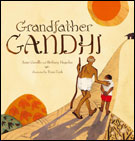
|
Grandfather Gandhi
by Arun Gandhi and Bethany Hegedus, illustrated by Evan Turk
Arun Gandhi, a grandson of Mohandas Gandhi, recounts a time in his childhood when he travelled with his father, mother, and sister from their home in South Africa to visit his grandfather, “Bapu,” in the Indian village of Sevagram. Young Arun has troubles: he’s worried he isn’t living up to the family name; he finds it nearly impossible to feel the peace and stillness that Bapu teaches; he feels like a fish out of water in a village that doesn’t even have electricity; he isn’t doing well in his studies; and he wishes for some private time with his grandfather but that’s nearly impossible due to the constant stream of aides, officials, and followers. Oh, his heart is heavy. After an altercation with another boy on the soccer field, Arun runs to his grandfather, with tears and blood streaming down his face, sure that Bapu will be disappointed. To the contrary, the “Great Soul” gives his grandson a life-changing lesson in anger. A month after the 9/11 tragedy, co-author Hegedus heard Arun speak and knew that she wanted to create a children’s book to share Gandhi’s lesson of “living our lives as light.” Turk uses watercolor, collage, tea, foil, and other media to produce art that is rich, warm, and evocative. Grandfather Gandhi is recommended for ages 4 to 7.
-- Becky Walton, MLIS, Collection Development
|
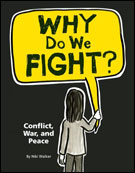
|
Why Do We Fight?: Conflict, War, and Peace
by Niki Walker
Niki Walker provides a much needed social sciences gap filler: an overview for middle schoolers of global conflict, its roots, its participants, its consequences, and possible solutions.
She discusses typical causes of conflict: the desire for power, equality, land, resources, and security. Throughout the book, Walker emphasizes that the roots of conflict are never simple; whether a conflict escalates to violence and war depends on a complex amalgam of factors. She illustrates this by examining the history of Afghanistan from 1747 to 2001. (This case study is one of the few times she cites a specific conflict; Walker states in her author’s note that she wanted to offer tools for thinking about conflicts rather than risk giving a perspective that could appear biased.) Next comes an examination of some of the ways conflicts are diffused (protests, strikes, courts); peace agreement processes; and the purpose of sanctions, mediations, and arbitrations. She concludes with a topic on which I would love to see more written for young people: independent thought. Knowing how to make informed opinions is key to being a good global citizen. She explains facts versus opinions, primary versus secondary sources. She reminds the reader that people speak from their perspective and that can lead to bias. After providing a propaganda checklist to help illuminate bias, she concludes with encouraging the reader to thinking independently; it isn’t what you think, but how you think. The writing is clear and appropriate for the audience; in one section, she uses the analogy of high school to explain the social, economic, and political interaction of countries (with the UN being much like the student council). Interspersed throughout the book are sidebar definitions of terms used in that section and relevant quotes from world leaders, philosophers, and activists. Why Do We Fight is highly recommended for ages 11 and up.
-- Becky Walton, MLIS, Collection Development
|
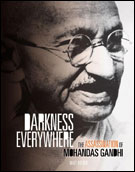
|
Darkness Everywhere: The Assassination of Mohandas Gandhi
by Matt Doeden
In Darkness Everywhere, the theme of light appears again. Author Matt Doeden takes his title from a quote by Indian Prime Minister Nehru announcing Gandhi’s death on the radio: “Gandhi has gone out of our lives and there is darkness everywhere.” On January 30, 1948, Mohandas Gandhi was shot and killed as he walked to the platform to begin the evening’s prayers. Doeden provides a brief biography of Gandhi as well as an explanation of the Indian caste system. Gandhi studied law but his path changed course when he faced racial prejudice in South Africa where he had taken his first job. After being removed from a train because of his skin color, he took up the fight to improve the lives of Indians, first in South Africa, then in British-controlled India. The author clearly explains the complicated issues in newly independent India that ultimately led to one of Gandhi’s own followers murdering him. Gandhi wanted his country’s two factions – the Hindus and the Muslims – to peacefully negotiate a partition to create Hindu-controlled India and Muslim-controlled Pakistan. But some extremist Hindus felt Gandhi was weak because of his attitude of tolerance. Doeden goes on to describe the group of Hindu men who plotted Gandhi’s death and by Chapter 4, which gives a detailed account of the day Gandhi was killed, the reading is riveting yet almost unbearable. End materials include an excerpt of the prime minister’s January 30, 1948, radio address; a timeline of events related to Gandhi’s life and death; a two-page synopsis of people discussed in the book; a glossary; source notes; bibliography, further reading sources; and an index. Recommended for ages 12 and up.
-- Becky Walton, MLIS, Collection Development
|

|



